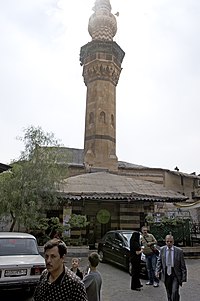 Ibn Arabi Mosque, also known as the Salimiyya Takiyya Mosque
Ibn Arabi Mosque, also known as the Salimiyya Takiyya Mosque Exterior view of the imaret of Sultan Salim at Salihiyya
Exterior view of the imaret of Sultan Salim at Salihiyya
The Salimiyya Takiyya (Arabic: التكية السليمية, romanized: at-Takiyya as-Salīmiyya) is a takiyya (Ottoman-era Arabic name for a mosque complex which served as a Sufi convent) in as-Salihiyya, Damascus.
The complex was built over and in the surroundings of Ibn Arabi's tomb in 924/1518 by the Ottoman sultan Selim I upon his return from the conquest of Egypt. The Salimiyya Takiyya is considered to have been "the first Ottoman building in Syria". However, its construction is considered to have followed "a local architectural idiom", which was "neither Mamluk, nor Ottoman" (unlike the later Sulaymaniyya Takiyya, which marked the introduction of the Ottoman architectural style to Damascus).
The Salimiyya Takiyya consists of a mosque (Ibn Arabi Mosque) and an imaret facing it.
History
Quoting Steve Tamari:
After returning from the conquest of Egypt in 1518, Selim I (r. 1512–20) commissioned the first Ottoman building in Syria, al-Takiyya al-Salimiyya, a Sufi retreat and mosque complex at the tomb of the Sufi master Muhyi al-Din Ibn al-ʿArabi (d. 1240) in the Salihiyya suburb north of Damascus proper. According to historians of the period, it was the center of educational life in Salihiyya, which itself was filled with Ayyubid- and Mamluk-era madrasas and was home to many of the city’s most prominent scholars. In fact, in the eighteenth century, al-Salimiyya ranked only behind the Umayyad Mosque and al-Sulaymaniyya al-Baraniyya as the third most important teaching institution in the city. In the sixteenth and seventeenth centuries, those who held the position of mudarris at the al-Salimiyya were closely tied to imperial power. The original nazir of the waqf was Turkish and a commission established to oversee construction was made up of the chief judge in Damascus and the sultan’s tutor. Yusuf Abi al-Fatah (d. 1646–47), for example, was imam to two sultans before returning to his home of Damascus and teaching at al-Salimiyya. During the eighteenth century, the teaching position was practically the preserve of two families, the Nabulusi and Mahasini families. Both were also prominent in the Salihiyya neighborhood. By this time, al-Salimiyya was eclipsed by al-Sulaymaniyya al-Baraniyya which became the preserve of the Hanafi mufti of Damascus.
Notes
- 33°31′46.25339″N 36°17′16.77282″E / 33.5295148306°N 36.2879924500°E / 33.5295148306; 36.2879924500
- 33°31′46.27564″N 36°17′15.80071″E / 33.5295210111°N 36.2877224194°E / 33.5295210111; 36.2877224194
- As worded by Helen Pfeifer, "the urban fabric did not acquire an Ottoman stamp until the middle of the sixteenth century".
References
- Al-Rihawi, Abd al-Qadir; Ouéchek, Émilie E. (1975). "Les deux takiyya de Damas". Bulletin d'études orientales. 28. pl. IV (page 12 of file).
- Al-Rihawi, Abd al-Qadir; Ouéchek, Émilie E. (1975). "Les deux takiyya de Damas". Bulletin d'études orientales. 28: 224 .
- Tamari, Steve (2009). "Between the "golden age" and the Renaissance". Trajectories of Education in the Arab World. p. 41.
- Helen Pfeifer (2022). Empire of Salons.
- Bulletin signalétique. 1978. p. 23.
ni mamelouk, ni ottoman
- Gérard Degeorge (1994). Damas. p. 46.
- Helen Pfeifer (2022). Empire of Salons.
- Tamari, Steve (2009). "Between the "golden age" and the Renaissance". Trajectories of Education in the Arab World. p. 41.
| Aleppo | |
|---|---|
| Damascus | |
| Daraa | |
| Hama | |
| Homs | |
| Idlib | |
| Latakia | |
| Raqqa | |
| Rif Dimashq | |